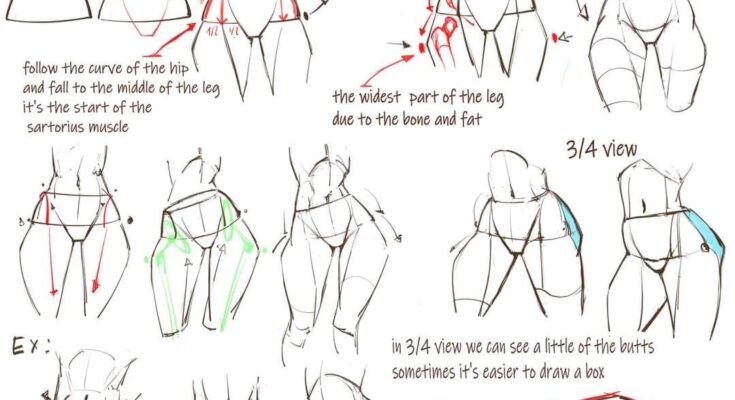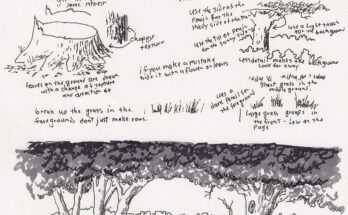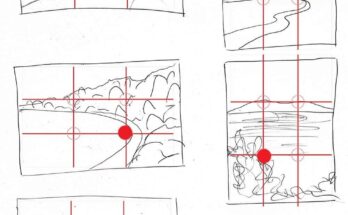Step-by-Step Tutorial on Drawing a Majestic Fantasy Dragon: Anatomy, Scales, and Wing Dynamics for Epic Illustrations

Crafting a majestic fantasy dragon is a pinnacle achievement for artists delving into fantasy art, gaming concepts, or mythological storytelling, blending anatomical realism with imaginative flair. This comprehensive tutorial is inspired by a reference sketch titled “Dragon,” which depicts a powerful, serpentine dragon in a dynamic coiled pose, with outstretched wings and a detailed head featuring horns and a toothy maw. Rendered in pencil with delicate shading, the image includes red construction lines to guide the pose’s flow, scale placement, and wing structure, alongside annotations highlighting key features like the muscular tail, clawed limbs, and textured hide. The composition suggests a perched or mid-flight stance, with a rugged landscape faintly sketched in the background, offering a foundation for artists to build a creature that exudes strength and mystique.
This guide is tailored for intermediate to advanced artists, whether working traditionally with graphite on textured paper or digitally using tools like Procreate, Photoshop, or Clip Studio Paint, where layers can manage complex elements. We’ll divide it into sections based on the reference: establishing the pose and anatomy, detailing scales and texture, constructing wings and limbs, and adding environmental context. Key techniques include using gesture lines for organic movement, applying overlapping scales for depth, and mastering perspective for wing dynamics. This approach suits fantasy book covers, game assets, or animated sequences, encouraging reference from real reptiles (e.g., snakes, lizards) or dragon mythology (e.g., European vs. Eastern styles). Begin with light sketching tools (e.g., H pencil or 20% opacity brush), a ruler for symmetry, and an eraser for adjustments, progressing to B pencils or opacity builds for shading. Given today’s date—01:09 PM EDT on Thursday, October 23, 2025—consider a midday sunlit scene to highlight the dragon’s scales.
Section 1: Establishing the Pose and Anatomy (Red Construction Lines)
The reference’s red lines form the dragon’s dynamic framework, capturing its coiled energy and balanced weight.
- Mapping the Gesture Line: Start with a flowing red line from the head, curving through the sinuous neck, torso, and tail, ending in a slight upward flick. The image shows a coiled pose with the body looping rightward, the head turned forward, and the tail anchoring the base. Draw this as a continuous S-shape, about 5-6 head lengths long, to convey serpentine grace.
- Marking Joints and Axes: Place red circles at major joints—neck base, shoulders, elbows, hips, knees, and tail segments—scaling them to prominence (e.g., larger at hips for weight). Add axes along limbs and wings: the front legs bend forward with claws extended, rear legs support the coil, and wings angle outward. The reference’s low perspective enhances the dragon’s dominance, so tilt the horizon upward.
- Perspective and Balance: Use a two-point perspective with vanishing points off-canvas to the left and right, converging lines toward the chest and tail tip. Ensure weight shifts to the rear legs, with the tail acting as a counterbalance. Tip: Observe a coiled snake photo to mimic the natural curve. Common error: Over-straightening—keep lines fluid. Exercise: Sketch 3 quick gestures of this pose (perched, flying, striking) using only red lines to build versatility.
This step locks in the dragon’s movement, preventing stiff or unnatural postures.
Section 2: Detailing Scales and Texture (Base Anatomy)
The reference’s pencil work defines a rugged hide, with scales adding texture and depth.
- Anatomical Base: Sketch the head as an elongated oval with a pronounced snout, adding horns as curved triangles and eyes as almond shapes. The torso is a thick, tapering cylinder, with the tail thinning to a whip-like end. Limbs are muscular ovals—front legs shorter for perching, rear legs longer for power. The image’s shading suggests a robust build, so emphasize muscle groups (e.g., shoulders, thighs).
- Scale Placement: Draw overlapping scales as small, irregular ovals or hexagons, starting at the head and flowing backward. The reference shows denser scales near the spine, fading to smoother skin on the underbelly. Use a staggered pattern—alternate rows for natural overlap—beginning with a centerline and radiating outward. Vary size: larger on the body, smaller on the face.
- Texture Refinement: Add texture with light cross-hatching for leathery skin and short strokes for horn ridges. The image’s annotations suggest shadow emphasis, so plan light from above-right. Avoid mistake: Uniform scales—introduce scars or worn patches for character. Exercise: Detail a head segment with scales and horns, then replicate across the body.
This builds a believable, textured surface, grounding the fantasy element in realism.
Section 3: Constructing Wings and Limbs (Wing Dynamics and Claws)
The reference’s wings and limbs enhance the dragon’s majestic presence, with detailed construction.
- Wing Structure: Sketch wings as bat-like membranes with a central arm (humerus) and elongated fingers supporting the skin. The image shows wings outstretched, with red lines indicating a curved span—about 1.5 times the body length. Draw the arm as a bent cylinder, adding finger joints (3-4 segments) with thin membranes between, tapering to points. Add veins or ridges for texture.
- Limb Detailing: Refine legs with clawed feet—draw three main toes with curved talons and a smaller dewclaw. The front legs bend at elbows for grip, rear legs straighten for support, with muscles bulging under scales. The reference’s pose suggests tension, so emphasize joint flex.
- Integration Tips: Align wings with the gesture line’s flow, tilting upward for lift. Ensure claws grip the ground or air, matching the coiled stance. Common pitfall: Disjointed wings—use perspective to converge finger tips. Exercise: Draw a single wing from multiple angles, then attach to the torso.
These elements amplify the dragon’s power and flight capability.
Section 4: Adding Environmental Context and Final Touches
The reference’s faint background and shading create an epic setting, enhanced by midday lighting.
- Environmental Context: Sketch a rocky perch with jagged lines, a misty valley below, and distant mountains as overlapping shapes. The image suggests a rugged landscape, so add sparse trees or boulders. With 01:09 PM EDT lighting, use a warm yellow-orange wash for sunlight, casting shadows leftward.
- Shading and Highlights: Apply gradients on a Multiply layer—darkest under wings, tail folds, and jawline; brightest on scale tops and wing edges. Use the above-right light source, adding specular highlights (small white dots) on scales for a glossy effect.
- Final Details: Add smoke or breath from the maw, faint scars on the hide, and a glint in the eye. The reference’s light shading hints at mist, so soften distant edges with a gray overlay (10-20% opacity).
- Critique and Adjustment: Erase guidelines, sign in a subtle corner (e.g., lower-right), and flip horizontally to check symmetry. Adjust shading if the dragon blends into the background.
Additional Professional Tips for Mastery
- Tools and Materials: 2H for outlines, 4B for shading; digitally, use custom scale brushes. Reference reptile skins or pterosaur fossils.
- Common Challenges: Scale overlap errors—practice on a grid. For lighting, study midday photos of glossy surfaces.
- Exercises and Resources: Daily: 20-minute dragon head studies. Explore “The Anatomy of Dragons” by G. L. McNamara or online creature design courses.
- Extensions: Add a rider, vary colors (e.g., green, red), or depict a fire-breathing scene for narrative depth.
This tutorial harnesses the reference’s structure, guiding you to create an epic fantasy dragon. Practice consistently, and explore our related guides for dragon variants or battle scenes!



